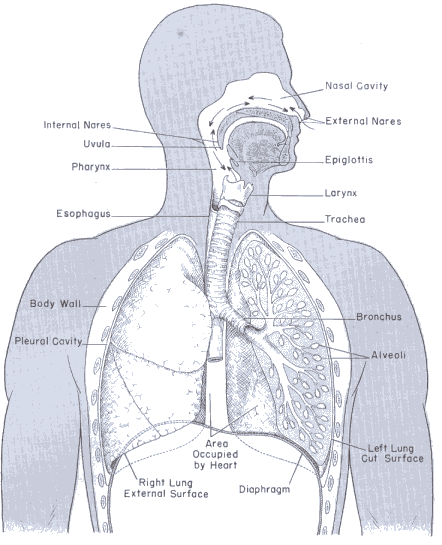
2 PROCESSES OF RESPIRATION
- External Respiration - External respiration occurs in the lungs, and involves the exchange of oxygen into, and carbon dioxide out of the bloodstream.
- Internal Respiration - Internal respiration occurs in all body cells, and involves the exchange of oxygen into, and carbon dioxide out of the bloodstream. The cells use the oxygen and glucose sugar to obtain energy, and produce carbon dioxide and water as waste products.
- Glucose Sugar +Oxygen
 Carbon Dioxide + Water + Energy
Carbon Dioxide + Water + Energy - C6H12O6 + O2
 CO2 + H2O + Energy
CO2 + H2O + Energy
FUNCTIONS OF RESPIRATORY ORGANS

Nose
- Air, containing 20% oxygen, enters the body through nostrils
- Air is cleaned and warmed as it passes through the nasal cavity
- Mucus and nose hairs serve to filter dust from the air
- Mucus also moistens the inhaled air
Pharynx
- Cavity at back of nose and mouth
- Both food and air pass through the pharynx
Larynx
- Voicebox
- When we swallow food, a flap called the epiglottis closes over the top of the larynx and below it, the trachea (windpipe) to prevent food entering the lungs
- As air passes through the vocal cords, different pitches of sound are produced
Trachea
- Windpipe
- Lies in front of the oesophagus (food tube)
- Protected at the front by C-shaped cartilage
- Fine hair-like hairs called cilia on the walls of the trachea 'brush' dust upwards and out of the respiratory tract
Bronchi (Singular - Bronchus)
- The trachea branches into 2 tubes called the bronchi - one going to each lung
- Mucus and cilia cover the walls of the bronchi
Bronchioles
- The right and left bronchi branch into many smaller tubes called the bronchioles
- Walls of bronchioles are lined with mucus and cilia
Alveoli (Singular - Alveolus)
- These are balloon -like air sacs at the ends of the bronchioles
- The walls of the alveoli are very thin, and are surrounded by fine blood capillaries
- Exchange or diffusion of oxygen into the blood from the inhaled air, and of carbon dioxide out of the blood to the exhaled air takes place
Diaphragm
- Large, dome-shaped muscle that lies at the base of the chest cavity
- The diaphragm contracts during inhalation, and relaxes during exhalation
THE MECHANICS OF BREATHING
Inhalation
- Breathing in
- The diaphragm and muscles between the ribs, and muscles attaching to the collarbone all contract
- This pulls the rib cage upwards at the top, outwards, and downwards at the bottom
- The chest cavity and the lungs inside expand in volume, creating lower air pressure inside the lungs compared with the outside air
- Air is then drawn into the lungs
Exhalation
- Breathing out
- The 3 lots of muscles relax
- The volume of the chest cavity and the lungs reduces
- The air pressure inside the lungs is then higher than the outside air, so air is forced out of the lungs
CONTROL OF BREATHING
- The respiratory control centre is in the hindbrain or Medulla Oblongata
- If too much carbon dioxide is detected in the bloodstream, it stimulates the respiratory tract to breathe